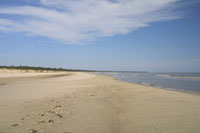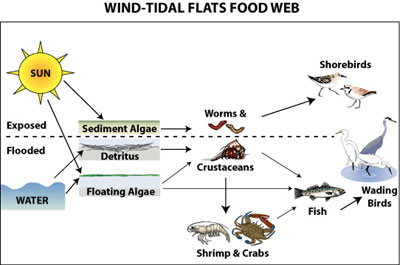|
History Animals & Plants Natural Communities Coastal Dry Uplands Upland Mesic Freshwater Marshes Forested Wetlands Fresh Water Estuaries |
Natural Communities and Habitats:
Coastal
In This Section:
Beaches/Coastal Strand | Tidal Flats/Salt Marsh
 A beach on the Gulf of Mexico (St. Vincent Island, Franklin County) (photo by Karla Brandt) |
Beaches are constantly reshaped by waves, winds, and tides. Waves and winds pick up sands and reshape the shoreline. Tides sweep sand, shells, and trash onto land and back out to sea. There's so much change in this zone that vegetation doesn't have a chance to get established. Both birds and sea turtles lay their eggs on beaches. Resident wading birds and migrating shorebirds feed at the water's edge.
Typical plants: None
Rare plants: None
Typical animals: great egret, great blue heron, reddish egret, snowy egret, willet, ruddy turnstone, black-bellied plover, sanderling, herring gull, laughing gull
Rare animals: snowy plover, piping plover, Wilson's plover, least tern, royal tern, Caspian tern, sandwich tern, American oystercatcher, black skimmer
Where to see it:
Bald Point State Park
St. George Island State Park
T.H. Stone Memorial St. Joseph Peninsula State Park
Coastal strand is the long, narrow strip between the beach on one side (where plants can't grow) and the much more stable communities on the inland side, which may be dry oak scrub, pineland, or hardwood forest. The coastal strand includes the inland edge of the beach as well as the dunes. Plants and animals must be tough to survive in the coastal strand. They must be adapted to salt spray, wind, and occasional flooding. Most of the plant species are vines, grasses, and herbs (that is, non-woody plants). After a storm wipes out the plants, the coastal strand is recolonized from seeds blown in on the wind or contributed in bird and animal droppings.
Dunes can be formed when the wind hits plants such as sea oats. The plants slow the wind down just enough to drop the sand it's carrying. Isn't it remarkable that these plants can withstand salt spray and strong winds but cannot survive human footsteps?
Typical plants: sea oats, beach morning glory, railroad vine, sandspur, seashore paspalum
Typical animals: ghost crab, six-lined racerunner, red-winged blackbird, savannah sparrow, raccoon
Rare plants: Godfrey's blazing star, large-leaved jointweed
Rare animals: *Green turtle, *loggerhead, *leatherback, Kemp's ridley, *diamondback terrapin, *snowy plover, piping plover, Wilson's plover, *least tern, *royal tern, Caspian tern, *sandwich tern, *American oystercatcher, *black skimmer, *St. Andrew's beach mouse
*Species that nest on coastal strand in the Apalachicola region
Where to see it:
Bald Point State Park
Cape St. George State Reserve
Dr. Julian G. Bruce St. George Island State Park
St. Vincent National Wildlife Refuge
T.H. Stone Memorial St. Joseph Peninsula State Park
Click here to see a map of beaches and coastal strand habitats in the western ARROW region.
Click here to see a map of beaches and coastal strand habitats in the eastern ARROW region.
 |
 |
Typical animals: Willet, sandpiper, dowitcher, white ibis, great egret, great blue heron, reddish egret, herring gull, laughing gull
Rare animals: Snowy plover, piping plover, Wilson's plover, least tern, royal tern, Caspian tern, sandwich tern, American oystercatcher, black skimmer
Where to see it:
St. Marks National Wildlife Refuge
Click here to see a map of tidal flats in the ARROW region.
 |
You can detect where the tide is strongest by which species of grass dominates. There's smooth cordgrass where the marsh is flooded by tides most frequently, and black needlerush where the tides don't reach quite as far. In transition zones between the marsh grasses and the adjacent uplands, you'll find glasswort, saltwort, and marsh elder.
Many of the salt marsh's inhabitants are seldom seen, but are sometimes heard. Listen for the clack-clack-clacking of clapper rails and the tremendously loud song of the tiny marsh wren, and if you're really and truly lucky, you'll hear the black rail's “KEEE-KEEE-doo.” For many birders, the black rail is a holy grail of sorts, because it is so seldom seen -- and not often heard, either.
Typical plants: smooth cordgrass, black needlerush, glasswort, saltwort, saltgrass, sea oxeye daisy, marsh elder, saltbush
Rare plants: Godfrey's spiderlily, corkwood
Rare animals: Gulf salt marsh snake, diamondback terrapin, Marian's marsh wren, Scott's seaside sparrow, black rail, Gulf salt marsh mink
Where to see it:
Bald Point State Park
Cape St. George State Reserve
Dr. Julian G. Bruce St. George Island State Park
Ochlockonee River State Park
St. Joseph Bay State Buffer Preserve
St. Marks National Wildlife Refuge
St. Vincent National Wildlife Refuge
Tate's Hell State Forest
T.H. Stone Memorial St. Joseph Peninsula State Park
Click here to see a map of salt marshes in the ARROW region.
Sources:
Florida Natural Areas Inventory and Florida Department of Natural Resources. 1990. Guide to the natural communities of Florida. Florida Natural Areas Inventory, Tallahasse, FL. Available at FNAI's website.
Glbert, T., and B. Stys. 2004. Descriptions of vegetation and land cover types mapped using Landsat imagery. Florida Fish and Wildlife Conservation Commission, Office of Environmental Services, Tallahassee, FL. Available at Florida Vegetation and Land Cover - 2003.
Note: The content of the website has not been updated since 2005. The site remains online for it's value as legacy content and is unlikely to be updated.